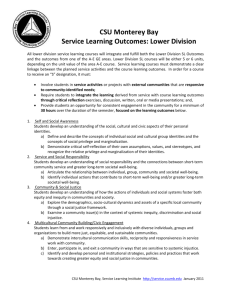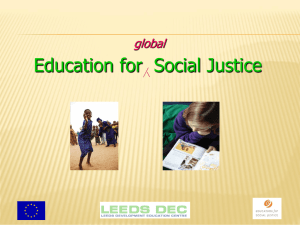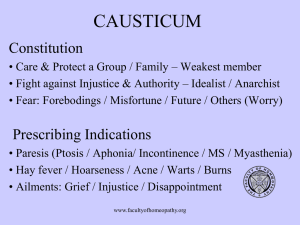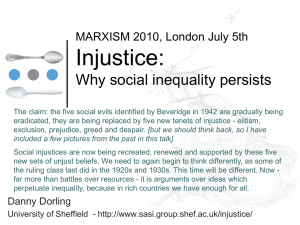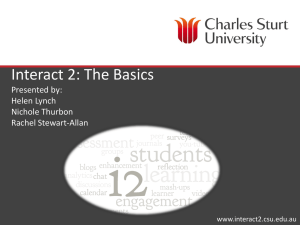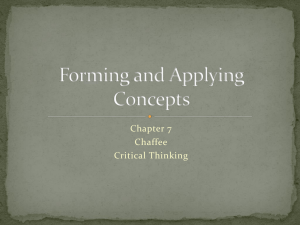Lower Division Curriculum Workbook
advertisement
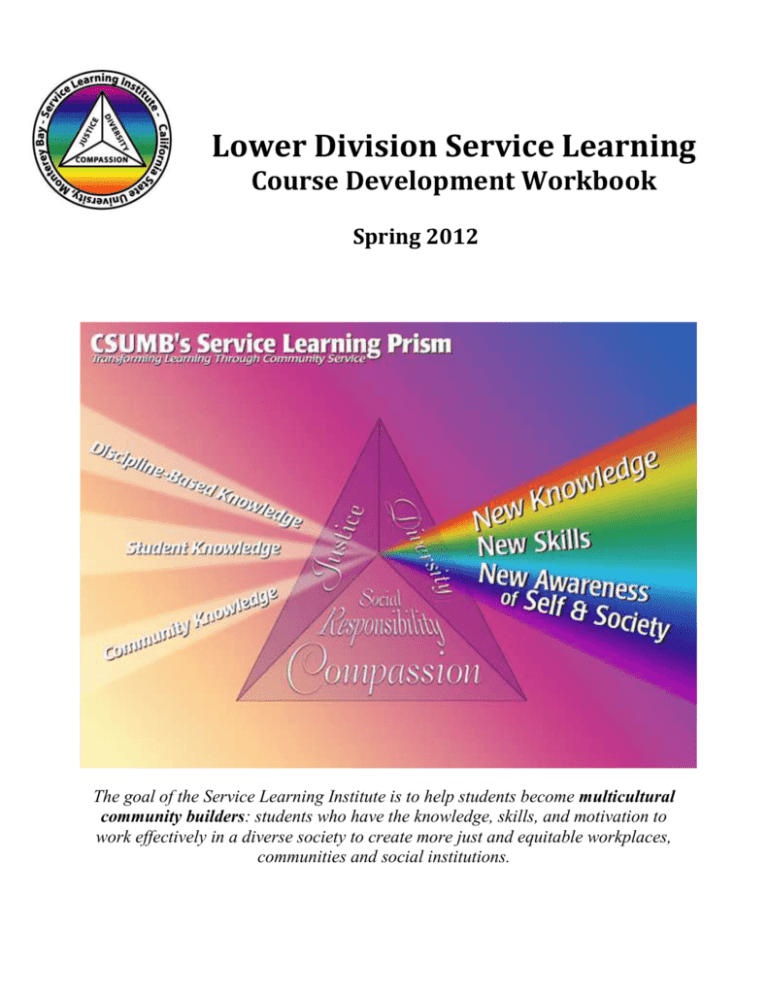
Lower Division Service Learning Course Development Workbook Spring 2012 The goal of the Service Learning Institute is to help students become multicultural community builders: students who have the knowledge, skills, and motivation to work effectively in a diverse society to create more just and equitable workplaces, communities and social institutions. CSU Monterey Bay: Service Learning Institute -Spring 2012 [2] CSU Monterey Bay Service Learning Outcomes: Lower Division All lower division service learning courses will integrate and fulfill both the Lower Division SL Outcomes and the outcomes from one of the A-E GE areas. Lower Division SL courses will be either 5 or 6 units, depending on the unit value of the area A-E course. Service learning courses must demonstrate a clear linkage between the planned service activities and the course learning outcomes. In order for a course to receive an “S” designation, it must: Involve students in service activities or projects with external communities that are responsive to communityidentified needs; Require students to integrate the learning derived from service with course learning outcomes through critical reflection exercises, discussion, written, oral or media presentations; and, Provide students an opportunity for consistent engagement in the community for a minimum of 30 hours over the duration of the semester, focused on the learning outcomes below. 1. Self and Social Awareness Students develop an understanding of the social, cultural and civic aspects of their personal identities. a) Define and describe the concepts of individual social and cultural group identities and the concepts of social privilege and marginalization. b) Demonstrate critical self-reflection of their own assumptions, values, and stereotypes, and recognize the relative privilege and marginalization of their identities. 2. Service and Social Responsibility Students develop an understanding of social responsibility and the connections between short-term community service and greater long-term societal well-being. a) Articulate the relationship between individual, group, community and societal well-being. b) Identify individual actions that contribute to short-term well-being and/or greater long-term societal wellbeing. 3. Community & Social Justice Students develop an understanding of how the actions of individuals and social systems foster both equity and inequity in communities and society. a) Explore the demographics, socio-cultural dynamics and assets of a specific local community through a social justice framework. b) Examine a community issue(s) in the context of systemic inequity, discrimination and social injustice. 4. Multicultural Community Building/Civic Engagement Students learn from and work responsively and inclusively with diverse individuals, groups and organizations to build more just, equitable, and sustainable communities. a) Demonstrate intercultural communication skills, reciprocity and responsiveness in service work with community. b) Enter, participate in, and exit a community in ways that are sensitive to systemic injustice. c) Identify and develop personal and institutional strategies, policies and practices that work towards creating greater equity and social justice in communities. CSU Monterey Bay: Service Learning Institute -Spring 2012 [3] Integrating Issues of INEQUALITY and INJUSTICE 1) Course Name and Number: 2) BRAINSTORM on Social Inequality: 3) The “BIG QUESTION”: How do issues of INEQUALITY and SOCIAL INJUSTICE relate to the themes of this course? How does your GE area relate to issues of INEQUALITY and SOCIAL INJUSTICE? How do INEQUALITY and SOCIAL INJUSTICE affect the personal lives and professional choices of students? How are INEQUALITY and SOCIAL INJUSTICE apparent in the communities where your students are from, and where your students will be serving? What is the overarching question about INEQUALITY and SOCIAL INJUSTICE that you want students to critically examine through their community experience? (Place the “Big Question” in the center of the Prism on the next page.) CSU Monterey Bay: Service Learning Institute -Spring 2012 [4] 4) Grounding the SL Outcomes in your Field Lower Division SL Learning Outcomes Self and Social Awareness Students develop an understanding of the social, cultural and civic aspects of their personal identities. Service and Social Responsibility Students develop an understanding of social responsibility and the connections between short-term community service and greater long-term societal well-being. Community & Social Justice Students develop an understanding of how the actions of individuals and social systems foster both equity and inequity in communities and society. Multicultural Community Building/Civic Engagement Students learn from and work responsively and inclusively with diverse individuals, groups and organizations to build more just, equitable, and sustainable communities. The BIG QUESTION : Relevant social justice issues Learning Outcomes Grounded in YOUR Field CSU Monterey Bay: Service Learning Institute -Spring 2012 [5] 5) Linking Learning Outcomes to Community Context and Service Activities Identify the community context and issues with which students will be engaging at the service site. Then, for each new learning outcome grounded in your field, identify relevant service activities or experiences that will provide students an opportunity to meet the outcome. Learning Outcomes Grounded in YOUR Field Community Context and Issues Service Activities CSU Monterey Bay: Service Learning Institute -Spring 2012 [6] 6) Identifying Learning Resources and Assessments 1) Self and Social Awareness Students develop an understanding of the social, cultural and civic aspects of their personal identities. WHAT IS BEING TAUGHT (content, concepts/theories, and skills as these relate to the outcomes) 1A) Define and describe the concepts of individual social and cultural group identities and the concepts of social privilege and marginalization. 1B) Demonstrate critical selfreflection of their own assumptions, values, and stereotypes, and recognize the relative privilege and marginalization of their identities. HOW IT IS BEING TAUGHT (learning resources, activities, assignments as these relate to the outcomes) CSU Monterey Bay: Service Learning Institute -Spring 2012 [7] 2) Service and Social Responsibility Students develop an understanding of social responsibility and the connections between short-term community service and greater long-term societal well-being. Learning Outcomes 2A) Articulate the relationship between individual, group, community and societal well-being. 2B) Identify individual actions that contribute to short-term well-being and/or greater long-term societal wellbeing. WHAT IS BEING TAUGHT (content, concepts/theories, and skills as these relate to the outcomes) HOW IT IS BEING TAUGHT (learning resources, activities, assignments as these relate to the outcomes) CSU Monterey Bay: Service Learning Institute -Spring 2012 [8] 3) Community & Social Justice Students develop an understanding of how the actions of individuals and social systems foster both equity and inequity in communities and society. Learning Outcomes 3A) Explore the demographics, sociocultural dynamics and assets of a specific local community through a social justice framework. 3B) Examine a community issue(s) in the context of systemic inequity, discrimination and social injustice. WHAT IS BEING TAUGHT (content, concepts/theories, and skills as these relate to the outcomes) HOW IT IS BEING TAUGHT (learning resources, activities, assignments as these relate to the outcomes) CSU Monterey Bay: Service Learning Institute -Spring 2012 [9] 4) Multicultural Community Building/Civic Engagement Students learn from and work responsively and inclusively with diverse individuals, groups and organizations to build more just, equitable, and sustainable communities. Learning Outcomes 4A) Demonstrate intercultural communication skills, reciprocity and responsiveness in service work with community. 4B) Enter, participate in, and exit a community in ways that are sensitive to systemic injustice. 4C) Identify and develop personal and institutional strategies, policies and practices that work towards creating greater equity and social justice in communities. WHAT IS BEING TAUGHT (content, concepts/theories, and skills as these relate to the outcomes) HOW IT IS BEING TAUGHT (learning resources, activities, assignments as these relate to the outcomes)
